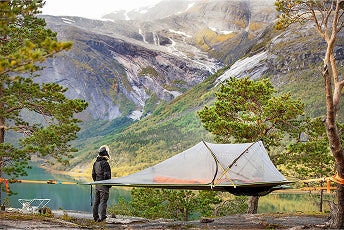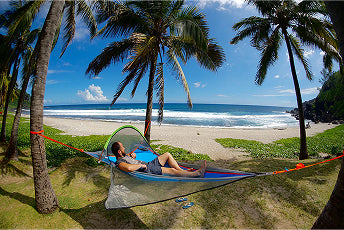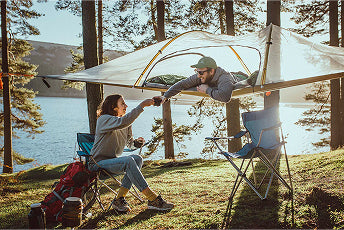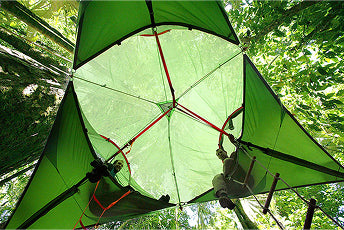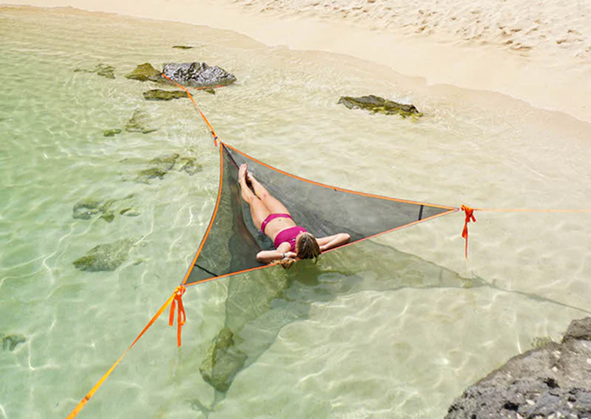As summer’s balmy nights draw to a close for the season, you may not be ready to give up the freedom of getting out into nature to enjoy that sense of peace and space. Armed with some know-how and insight, there really is no need to give up on those dreams and you can continue exploring and adventuring well into the colder months!
The main rule on keeping warm on a cold weather camping trip is to be prepared. This means eating and drinking well and bringing the right gear! Tree Tents are perfect for wild winter camping for many reasons, not least because you can pitch them over any type of ground condition; be it covered in vegetation, rocks, on an incline or just plain muddy. Just like a hammock, a Tree Tent will give you that extra bit of versatility in terms of where and when you can camp. But with Tree Tents, you can share this space with other people and can have a super flat bed!
However you like to sleep, the key to sleeping well in a tree tent on a cold night is finding a sheltered campsite. A place that is protected from the wind is best, as wind is the natural enemy of warmth. Whether it be blowing your fire or stove all over the place, rattling your tent all night, or stealing the warm air from your bed, you want to be as sheltered as possible and for as long as possible.
Being suspended off the ground means that you will not be fighting heat loss from the cold ground, but you may need to protect yourself from the cold wind. Luckily, there are many ways to do this without adding too much weight and they will all enhance your experience level of comfort.
After a good tent, the best bits of gear you can have are a good air mattress/inflatable pad and sleeping bag. An air mattress will protect the underside of your body from the cold by creating a buffer layer of warm air (warmed by your body). As heat is best conducted through solid matter, the air is actually one of the best insulators (bested only by a vacuum).
A good sleeping bag works in the same way. By using down (feathers) or hollow fibre filling, a sleeping bag will trap your body heat around you so that cold air cannot get close to your body. The weakness point here is the side you sleep on, as this will compress the down/fibres and push out the insulting air buffer--which is where the mattress comes in.
Tentsile Sky-Pad inflatable sleeping pad is made by Klymit, one of the leading US brands in the field. The Sky-Pad has been designed to fit every Tentsile Tree Tent model, with its two-chamber construction and snap-buttons to give added flexibility and versatility if used. The pads can easily be fitting between the double skin floors of our lightweight range of Tree Tents or added into the larger models to be covered by an inner sheet that holds them in place.
Cold weather often means that your tent will be warmer on the inside than the outside, and this will create condensation—small droplets of water forming on the inside surface of your rainfly. To combat this, you should ensure a decent level of airflow in order to help this evaporate. No one wants to have freezing water dripping on their heads at night! We would recommend that you keep at least one side of the Tree Tent legged out to help with this airflow, or make sure your tent has a 2-3”/6-8cm gap between the rainfly and ground to allow air to circulate.
Finally, eat well and layer up! It seems obvious, but the best thing you can do to keep warm is to make sure you are well-fed and have access to a hot drink if you need one. Your body needs the energy to stave off the cold and being able to have a heat source such as fire or stove will give your core the added boost of warmth you’ll need to stay cosy all through the night. Layered clothing is paramount. You can always take layers off if you end up not needing them, but it is harder to warm up than it is to cool down so don’t go to bed cold! And make sure you’ve gone to the toilet before you tuck yourself in…. that can be annoying.

